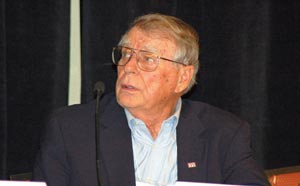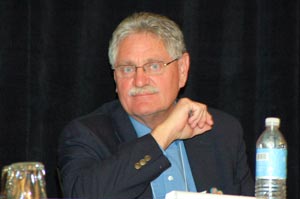ILC–USA 2012
How, What Are We Going To Feed Cattle?
by Troy Smith for Angus Productions Inc.
DENVER (Jan. 10, 2012) — The International Livestock Congress(ILC)–USA 2012, hosted Jan. 10 in Denver, Colo., provided a forum for discussing the future of cattle feeding. Sharing their views were long-time consulting nutritionist and cattle feeding entrepreneur Hollis Klett and livestock feed supplement manufacturer Joe Harris. Their comments shared a common thread in predicting continued and expanded reliance on commodity byproducts in formulation of cattle rations.

Hollis Klett, owner of a Texas feedyard and a ranch in New Mexico. PHOTOS BY TROY SMITH
The owner of a Texas feedyard and a ranch in New Mexico, Amarillo-based Klett has worked internationally as a cattle feeding consultant. Klett said one of the biggest challenges going forward may be the $1,400 to $1,500 per head line of credit required to feed cattle. Driving that is the high cost of feedgrains, especially corn. Klett said the use of commodity byproducts as ration ingredients has been important to holding down total feed costs. He expects byproduct utilization to increase.
“I would have never dreamed, 30 years ago, that we would be using these ingredients in finishing programs,” stated Klett. “But we’ve reduced the amount of corn in rations by half — from 70% to about 35% — by using distillers’ grains, corn gluten pellets, sweet bran and other byproducts. It probably saved our lives.”

Joe Harris, executive vice president of Westway Feed Products
Joe Harris, executive vice president of Westway Feed Products, noted how utilization of distillers’ grains has increased dramatically during the last few years. He said most is being used by cattle growing and finishing operations, but more cow-calf operations are using distillers’ grains, too.
“Will we see more and different kinds of byproducts used? It’s possible,” said Harris, recounting a long history of using, as feed for livestock, the leftovers from human food processing or product manufacturing.
“It’s not new,” he added, “taking the garbage and turning it into feed. I recently looked at a new potential feed ingredient that is a byproduct of manufacturing tissue paper.”
Asked about potential changes to the U.S. beef production system, Harris called the three-sector (cow-calf, stocker and finishing) system reasonably environmentally friendly. He sees a definite place for stocker operators to package and prepare cattle for the finishing sector. He recommended they seek opportunities to grow more forage and harvest it with cattle supplemented with byproduct feeds.
Harris believes the cow-calf segment’s reproductive efficiency could be improved if more producers sought to understand their available forage base and the “how and when” of supplementation. Klett said he sees opportunity, worldwide, for increasing total beef production through management strategies targeting improved reproductive efficiency.
For additional coverage of ILC–2012, return to the ILC index page.
Editor’s Note: The above article was written under contract or by staff of Angus Productions Inc. (API). It may not be reprinted without express permission of API. To request reprint permision, contact the editor at 816-383-5200.
This section of the API Virtual Library contains event coverage provided by the editorial team at Angus Productions Inc. (API), publisher of the Angus Journal, the Angus Beef Bulletin, the Angus Beef Bulletin EXTRA and the Angus e-List. For questions about this site, to submit an article for our consideration, or to report a broken link, contact the editor at 816-383-5200; 3201 Frederick Ave., Saint Joseph, MO 64506.
API claims copyright to this website as presented. We welcome educational venues and cattlemen to link to this site as a service to their audience.






